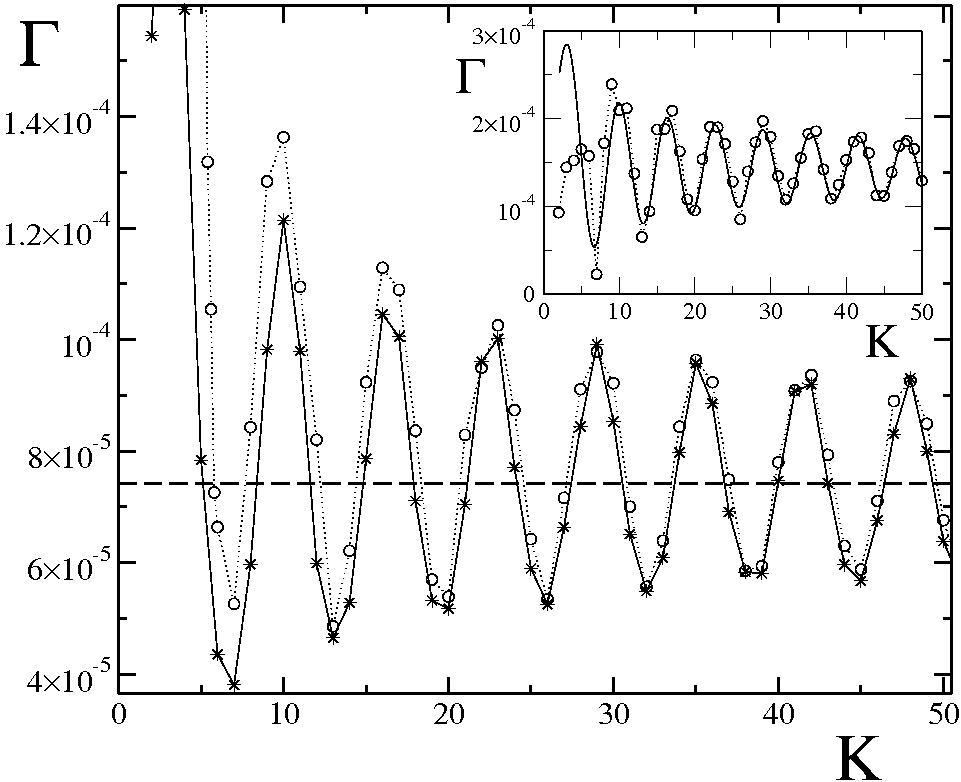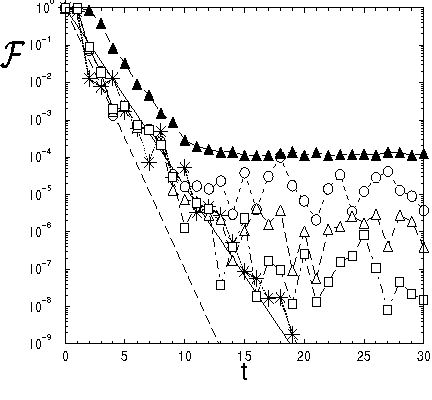Quantum dephasing and internal chaos
It turns out that a moderately weak coupling to a disordered
environment, which destroys the quantum phase correlations thus
inducing decoherence, yields an exponential decay of the fidelity of
quantum motion, with a rate which is determined by the system's
Lyapunov exponent and independent of the perturbation (coupling)
strength. In other words, quantum interference becomes irrelevant and
the decay of fidelity is entirely determined by classical chaos. This
result raises the interesting question whether the classical chaos, in the absence of any environmentstarts from a wide and incoherent mixed
state (we remark in this connection that any classical device is
capable of preparing only incoherent mixed states described by diagonal
density matrices) then the initial incoherence persists due to the
intrinsic classical chaos so that the quantum phases remain irrelevant.
In order to illustrate the quantum dephasing
induced by
classical chaos, we have introduced an extension of fidelity (which we
named allegiance) for mixed states. The allegiance directly accounts
for quantum interference and is measurable in a Ramsey interferometry experiment.
We have shown that, in the semiclassical limit, the decay of this
quantity is exactly expressed, due to the dephasing, in terms of an
appropriate classical correlation function. Our results have been
derived analytically for the case of a nonlinear driven oscillator and
then numerically confirmed for the kicked rotor model.
and only with a perfectly deterministic perturbation, can by
itself
produce incoherent mixing of the quantum phases (dephasing) strongly
enough to fully suppress the quantum interference. The answer is,
generally, negative. Indeed, even though the dynamics is chaotic, still
there always exist a lot of very close trajectories whose actions
differ only by terms of the order of Planck's constant. Interference of
such trajectories remains strong. We have shown [2] that, nevertheless,
if the system is classically chaotic and the evolution
Decay of allegiance for the kicked
rotor model (see [2])
Note that allegiance is naturally measured in experiments
performed on cold atoms in optical lattices and in atom optics billiard
and proposed for superconducting nanocircuits [3]. This quantity is
reconstructed after averaging the amplitudes over several experimental
runs (or many atoms). Each run may differ from the previous one in the
external noise realization and/or in the initial conditions drawn, for
instance, from a thermal distribution. Note that the averaged (over
noise) fidelity amplitude (that is, allegiance)can exhibit rather
different behavior with respect to the averaged fidelity [3]
Schematic drawing of a
superconducting device that might be used to measure allegiance: a
Cooper pair shuttle (dashed red box) is capacitively coupled to a
Cooper pair box (dot-dashed green box) (see [3]).
References
[1] D. Rossini, G. Benenti and
G. Casati, Conservative chaotic map
as a model of quantum many-body environment, Phys. Rev. E 74, 036209 (2006).
[2] V.V. Sokolov, G. Benenti and G. Casati, Quantum dephasing and decay of classical
correlation functions in chaotic systems, Phys. Rev. E 75, 026213 (2007).
[3] S. Montangero, A. Romito, G. Benenti and R. Fazio, Chaotic dynamics in superconducting
nanocircuits, Europhys. Lett. 71,
893 (2005).



